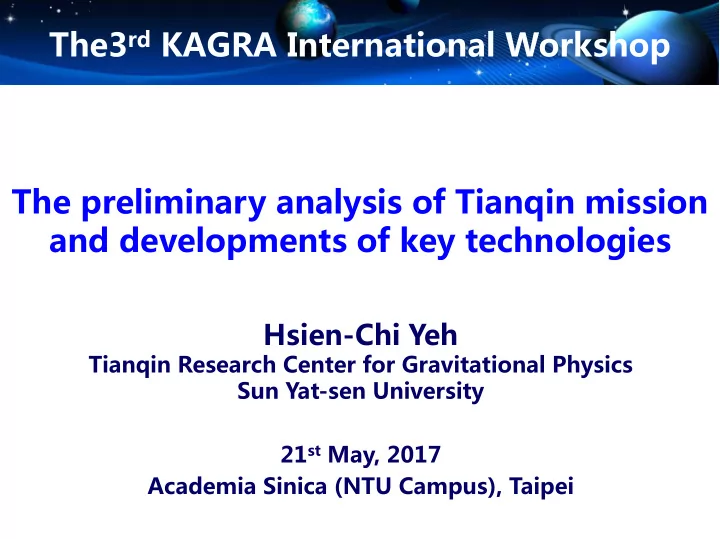

The3 rd KAGRA International Workshop The preliminary analysis of Tianqin mission and developments of key technologies Hsien-Chi Yeh Tianqin Research Center for Gravitational Physics Sun Yat-sen University 21 st May, 2017 Academia Sinica (NTU Campus), Taipei
Outlines 1. TianQin mission concept 2. Key technologies 3. Development strategy 4. Current status & progress
Meanings of GW detection Fundamental physics: Test theories of gravity in the strong field regime. Gravitational-wave astronomy: Provide a new tool to explore black holes, dark matters, early universe and evolution of universe.
LIGO GW Antenna Merging of 2 black holes 1915:General Relativity 1916:prediction of GW 1962:interferometer antenna 1984:initiating LIGO 2002:LIGO started exp. 2010:upgrade aLIGO 2016:GW detected
Why we need space GW detections? GW spectrum and detectors Significances: p abuntant types of sources Binary systems(white dwarfs、neutron stars、 black holes)、merging of massive black holes、 primordial GW p stable sources Compact binaries p strongest sources Binary super-massive black holes
Space GW mission concepts ASTROD-GW eLISA/NGO Solar orbit Geocentric orbit LAGRANGE OMEGA
TianQin Mission Concept Guidelines: • Geocentric orbit, shorter arm-length, higher feasibility; • Target a well-known GW source (location and GW frequency) first, as the“calibrated source”;
TianQin GW Antenna Orbit: geocentric orbit with altitude of 100,000km; • Configuration: 3-satellite triangular constellation, • nearly vertical to the Ecliptic; “Calibrated” source: J0806.3+1527, close to the • ecliptic; Detection time window: 3 months; •
Exa xample of possi ssible orbits s (1 (1*10 10 5 km km) Panels 1,2,3,7 : Range rate (<10m/s) Panels 4,5,6,8: Variation of subtended angles (Short term <0.1 deg.; Long term <0.2 deg.) Panels 7,8: More detail in first few months.
Sensitivity goal Gravitational wave from RX J0806.3+1527 • Masses (0.5, 0.27) Msun G.H.A.Roelofs et al, ApJ, 711, L138 (2010) • Period 321.5s (distance between stars 66000km) T.E.Strohmayer, ApJ, 627,920(2005) Simbad data base • Distance (0.05 ~ 5) kpc • Strain • Integrated strength (90days) • Relation to noise (SNR=10) : Transfer function S_x Noise in distance measurement; S_a Noise in acceleration
Sensitivity Curve of TianQin Assuming 90 days of integration time for TIANQIN Para. eLISA TianQin 10 6 km 1.7*10 5 km Arm Len. 7*10 -15 m/s 2 /Hz 1/2 3*10 -15 m/s 2 /Hz 1/2 Sa 1/2 Sx 1/2 10 pm/Hz 1/2 1 pm/Hz 1/2
Configuration of Space GW Antenna Single Satellite Triangular constellation
Requirements Key Technologies Specifications Inertial Proof mass magnetic susceptibility 10 -5 Residual charge 1.7*10 -13 C sensing & Contact potential 100uV/Hz 1/2 @ 10mV Drag-free Cap. Sensor 1.7*10 -6 pF/Hz 1/2 ( 3nm/Hz 1/2 ) @ 5mm control Temp. stability 5uK/Hz 1/2 Residual magnetic 10 -15 m/s 2 /Hz 1/2 2*10 -7 T/Hz 1/2 field Satellite remanence 1Am 2 @0.8m uN-thruster 100 uN (max); 0.1 uN/Hz 1/2 Space Nd:YAG Laser Power 4 W, Freq. noise 0.1 mHz/Hz 1/2 Interferometry Telescope Diameter 20 cm Phasemeter Resolution 10 -6 rad 1pm/Hz 1/2 Offset & jitter 10 -8 rad/Hz 1/2 Pointing control Wavefront l /10 distortion thermal drift of OB 5nm/K
Key Technologies n Femto-g Drag-free control: Ø Ultraprecision inertial sensing: ACC, proof mass Ø uN-thruster: continuously adjustable, 5-year lifetime Ø Charge management (UV discharge) n Picometer laser interferometry: Ø Laser freq. stab.: PDH scheme + TDI Ø Ultra-stable OB: thermal drift 1nm/K Ø Phase meas. & weal-light OPLL: 10 -6 rad,1nW Ø Pointing control: 10 -8 rad@10 6 km n Ultrastable satellite platform: Ø Stable constellation: min. velocity and breathing angle Ø Environment control: temperature, magnetic field, gravity and gravity gradient Ø Satellite orbiting: position(100m), velocity(0.1mm/s) (VLBI+SLR)
Development Strategy • Technology verification for every 5 years; • One mission for each step with concrete science objectives.
Roadmap 3 2 GW detection 1 Global Gravity 0 Test of E.P . E.P ., 1/r 2 , Ġ, … • Precision satellite formation fly • Picometer space interferometry • Intersatellite • Femto-g drag-free laser ranging • Inertial sensing control • Precision • Drag-free • LLR accelerometer control • High-altitude • Laser satellite interferometer positioning 2016-2020 2021-2030 2031-2035
Four Steps to GWD Step-0: Technology Lunar laser ranging objectives 2016-2020 Precision laser • ranging to high orbit spacecrafts Science objectives Testing fundamental laws in physics • Studying physics of the Earth-Moon • system
Four Steps to GWD Step-1: Technology Test of equivalence principle in objectives space Dragfree 10 - • 2016-2025 10 m/s 2 Inertial sensor • 10 -12 m/s 2 Micro-thruster • 100μN Spaceborne • laser 100Hz Science objectives Testing EP to 10 -16 • J. Jpn. Soc. Microgravity Appl. 25(2008)423-425.
Four Steps to GWD Step-2: Technology Next generation gravity objectives Inertial sensor satellite • 10 -10 m/s 2 2016-2025 10nm@100km • Science objectives Earth • Global climate • Rev. Sci. Instrum. 82, 044501 (2011) change
Four Steps to GWD Step-3: Technology TianQin objectives Inertial sensor 2016-2035 • 10 -15 m/s 2 Dragfree 10 - • 13 m/s 2 1pm@10 7 m • μN-thruster • Science objectives General • Relativity Class. Quantum Grav. 33, 035010 (2016) GW astronomy •
Precision Inertial Sensing 1996-2000: develop flexure-type ACC 2001-2005: space test of flexure-type ACC — launched in 2006 2006-2010: develop electrostatic ACC 2011-2015: space test of electrostatic ACC — launched in 2013
Space Laser Interferometry 2006-2010: (10m) nm laser interferometer 2011-2015: (200km) inter-satellite laser ranging system Picometer laser interferometer • nW weak light OPLL • nrad pointing angle measurement • 10Hz space-qualified laser freq. stab. • Thermal Shield
Large-aperture CCR & SLR Yunnan station Laser Ranging for CE 4 relay satellite Manufacturing next-generation • laser ranging CCR Upgrading ground stations • Large-aperture hollow CCR
Basic Infrastructure at Zhuhai (2016-2019) Laser Ranging Station Research Center Cave Lab.
Conclusions 1. Tianqin will develop all key technologies required for space-based GW detection step by step in the following 15 years. 2. Aiming at frequency range of 1mHz-1Hz, Tianqin can provide joint observations with LIGO, KAGRA and LISA. 3. Collaboration with DESIGO should be considered seriously, including studying science cases and developing key technologies required for both missions.
Thanks for your attentions!
Recommend
More recommend